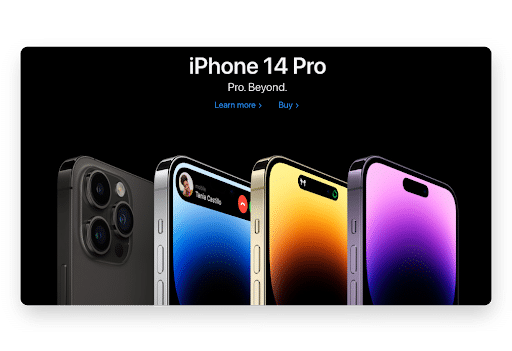Picture this: you’ve spent countless hours designing your website, making it visually stunning, easy to navigate, and brimming with valuable content.
But, as your analytics stare back at you, a nagging question lingers: why aren’t your conversion rates soaring as high as your aspirations?
It’s time to think beyond design and dive into the world of color psychology marketing. The colors you choose for your website color schemes can significantly affect your conversion rates.
Studies have shown that up to 90% of snap judgments about products can be based on color alone.
Our Chief Creative Officer, Oscar Lutteroth, notes that while color options are important, brands must make sure that they are adhering to guidelines and not steering into colors that don’t make sense. He believes you can make an impact within your existing color palette.
In this article, you’ll learn about what each color means and how to effectively use them within your marketing strategy.
Ignite Visibility’s Web Development Project Manager, Rene Castro, will walk you through an exploration of the fascinating (and sometimes surprising) ways color psychology influences your audience’s decision-making process and how you can harness its power to boost your conversion rates.
Principles of Color Psychology
We root color psychology in the idea that colors evoke specific emotions and behaviors in people—a concept that’s been around for centuries.
As it turns out, our brains are wired to respond to colors in fascinating ways. So let’s look at the psychology behind each color and how brands have used this knowledge.
Pink
Romantic and feminine, pink is often used to communicate warmth and affection. It’s no surprise that Victoria’s Secret, known for its women’s products, embraces pink in its branding to evoke sensuality and romance.

Color Psychology Marketing – Pink
Red
Red is a powerful attention-grabber. Bursting with energy and excitement, brands like Netflix and Target have harnessed the power of red to create a sense of urgency and stand out in a crowded marketplace.

Color Psychology Marketing – Red
Orange
Aggressive and action-oriented brands use orange to stimulate activity and decision-making.
Home Depot’s iconic orange branding encourages customers to roll up their sleeves and tackle their DIY projects head-on.

Color Psychology Marketing – Orange
Yellow
With its sunny disposition, yellow is synonymous with optimism and happiness. McDonald’s golden arches embody this cheerful vibe, inviting patrons to chow down a quick and satisfying meal (both with their website color scheme and in real life).

Color Psychology Marketing – Yellow
Green
Green is associated with wealth and growth. It is often used to convey prosperity and sustainability. Whole Foods Market’s use of green reinforces its commitment to organic, environmentally friendly products.

Color Psychology Marketing – Green
Blue
The epitome of trust and reliability, blue is a favorite among financial institutions like Visa and PayPal. These companies rely on the calming effect of blue to instill confidence in their users.
Purple
Purple’s soothing and luxurious vibes make it a go-to for high-end brands.
Cadbury’s elegant purple packaging evokes a sense of indulgence and sophistication, perfectly complementing its premium chocolate offerings.

Color Psychology Marketing – Purple
Brown
Dependable and earthy, companies use brown to convey stability and comfort. UPS, the logistics giant, uses brown branding to emphasize its reliable delivery services.

Color Psychology Marketing – Brown
Black
Black is known for exuding luxury and sophistication. It is a classic choice for high-end brands. Apple’s sleek black branding, for instance, underscores the premium quality of its products.

Color Psychology Marketing – Black
White
The epitome of simplicity and cleanliness, white communicates minimalism and purity. Google’s predominantly white homepage conveys its straightforward, user-friendly approach to search.

Color Psychology Marketing – White
Colors & Decision-Making
Colors have a sneaky way of nudging us toward decision-making, often without realizing it.
As we’ve seen, each color triggers specific emotional responses, and savvy marketers know how to capitalize on this to influence consumer behavior with their website color scheme.
Let’s dive into the chromatic world of decision-making and see how colors can work their magic on our choices.
First Impressions
First things first, impressions. According to a study by CCICOLOR, people make up their minds about products within 90 seconds, and up to 90% of this assessment is based on color alone.
That’s right—colors can decide whether a potential customer swipes their card or walks away.
Take, for example, the famous Heinz ketchup color switch.
When Heinz introduced a new ketchup color—green—their sales skyrocketed, with over 10 million bottles sold in the first seven months.

Heinz Green Tomato Ketchup
The unconventional hue sparked curiosity and excitement, leading consumers to try it out.
Companies like Tiffany & Co. have leveraged this to create an iconic brand image.

Tiffany & Co. Teal Blue Branding
Their distinctive Tiffany Blue color is instantly recognizable, evoking feelings of luxury and sophistication.
But it’s not just about catching the eye—colors can also affect how we perceive value.
For instance, people are more likely to perceive a product as expensive and high-quality when its logo is presented in gold, even when compared to the same logo in silver or bronze.
The perception of its value increased by associating the product with a color that signifies wealth.
Another fascinating aspect of color’s influence on decision-making is its ability to create a sense of urgency.
The color red, for example, has been found to increase the speed and force of reactions. This is why you’ll often see red used in clearance sales and countdown timers—it subtly encourages shoppers to act quickly, before time runs out or stock disappears.
To leverage the power of colors in your marketing, it’s essential to understand your target audience and the emotions you want to evoke.
Just remember that different cultures might associate colors with different meanings, so it’s crucial to have a ground-level understanding of these nuances when creating a global brand.
Using Color to Increase Conversions
Ready to give your conversion rates a colorful makeover?
Just remember, Picasso didn’t become a master overnight—so don’t be afraid to experiment and test your way to chromatic success.
Know Your Audience: Different demographics may respond differently to colors. For example, men and women tend to prefer different hues. Do your research to understand the preferences of your target market and choose colors that resonate with them.
Create Contrast: Ensure your call-to-action (CTA) buttons stand out from the rest of your design. For example, a green CTA button could increase conversions compared to a red one simply because it contrasts better with your site’s color scheme.
Leverage Color Associations: Use the psychology of color to evoke specific emotions and drive action. For instance, consider using red if you want to create a sense of urgency for a limited-time offer. Or, if you’re aiming to convey trust and reliability, blue might be your go-to hue.
Check out this infographic for a quick refresher on color associations.
Consistency is Key: Maintain a consistent color scheme across your website and marketing materials to strengthen your brand identity. Color consistency can massively improve brand recognition and customer loyalty.
Test, Test, Test: A/B testing is your best friend when optimizing your website’s colors. Try different color combinations to see which one gets more engagement and conversions. Back when Hubspot was known as Performable, they ran an A/B test on their landing page. All they did was change the button color from green to red.
The result? 21% more clicks on the green one.
Don’t Forget About Accessibility: Ensure your website is accessible to people with color vision deficiencies. Use tools like Color Oracle or WebAIM’s Contrast Checker to verify that your color choices maintain adequate contrast and readability.
Embrace White Space: Sometimes, less is more. Using white space strategically can make your content more digestible and draw attention to crucial elements on your site. As shown above, Google’s clean and minimalist homepage is a prime example of white space done right.
Colors & Conversion Rates
Color psychology is a secret weapon in any marketer’s arsenal, and it’s no wonder why.
By leveraging this innate connection, you can turn your website into a conversion-generating machine that leaves your competitors green with envy.
The importance of color psychology as a tool to improve conversions lies in its ability to create emotional connections with your audience.
As Maya Angelou once said, “People will forget what you said…but people will never forget how you made them feel.”
When your website’s colors evoke positive emotions, visitors are more likely to trust your brand and feel confident in taking action.
Take, for instance, Coca-Cola’s iconic red branding. The bold red color elicits excitement and energy, making it impossible to ignore on store shelves.
This strong emotional response has helped Coca-Cola become one of the most recognizable brands in the world.
Colors also play a crucial role in decision-making, influencing factors like perceived value and urgency.
A few years ago, Amazon tested changing its “Buy Now” button to blue. While Amazon doesn’t publicly disclose the results of it’s A/B tests, we can presume their “urgent orange” received better results.
By understanding color psychology and testing various color combinations, Amazon optimized its website and encouraged more visitors to complete their purchases.
9 Ways Marketers Can Leverage Colors
Ready to paint the town red (or blue, or green) with your marketing strategy?
Here’s how businesses can harness the power of colors to create a visually stunning and effective marketing plan that will have your audience doing a double-take:
1. Use color psychology to your advantage: As previously explored, each color is a psychological sorcerer, conjuring emotions and swaying behavior. Choosing the correct hues can enchant your audience, guiding them toward taking action.
2. Create a strong and consistent brand identity: A harmonious color scheme across marketing channels bolsters brand recognition, boosting customer loyalty.
3. Use colors to highlight important elements: By using contrasting colors, you will draw attention to crucial aspects of your marketing materials, like CTA buttons or special offers. This technique, known as the isolation effect, states that items that stand out are more likely to be remembered.
4. Experiment with color combinations: Test various color combinations in your marketing materials to find the most effective hues for your audience. A/B testing is an excellent way to determine which colors drive engagement and conversions.
5. Mind the context: The context surrounding your marketing materials can shift color perception. Ensure your chosen colors work across your ads, websites, and other marketing assets.
6. Use colors to evoke a specific mood: The overall color palette of your marketing materials can create a specific atmosphere or mood, affecting how your audience perceives your brand.
7. Be mindful of seasonal color trends: Align your marketing campaigns with seasonal color trends to stay relevant and appealing. For instance, incorporating warm, earthy tones during autumn or bright, vibrant hues in the summer can make your marketing materials feel more timely and engaging.
8. Harness the power of color in storytelling: Use colors to enhance your brand’s storytelling and create memorable marketing campaigns. Marketers who use vibrant or energetic color palettes can highlight different services or products available.
9. Use an isolated color: By picking and sticking to one isolated color, you’ll draw your audience’s attention and make more of an impact. Are all your CTAs blue? Make your primary CTA Green so that it stands out.
By masterfully weaving colors into your marketing strategy, you can create mesmerizing campaigns that resonate with your audience, forge a solid brand identity, and ultimately drive conversions.
Marketing is a Canvas
Colors are the unsung heroes of the marketing world—these vibrant virtuosos hold the power to captivate audiences, forge unbreakable brand identities, and skyrocket conversions.
Who knew a splash of hue could make such a monumental impact?
So chromatic enthusiasts, it’s time to take a leaf out of Bob Ross’s playbook and create some happy little marketing masterpieces bursting with color and personality.
Remember, the marketing canvas is yours to paint—dare to be bold and make every stroke count.


